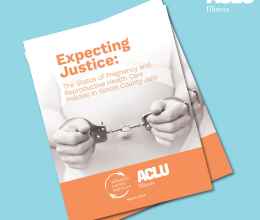By Patrice Bugelas-Brandt, Communications Department Volunteer
A survey by the Journal of American Medical Association, released this week, reveals that seven out of ten Americans support the Affordable Care Act’s requirement that employer sponsored health care packages include contraceptive coverage. Seven out of ten Americans clearly understand that contraceptive coverage is a critical health care issue for women.
Yet, for the next few months, the country is debating a very real question: will five out of nine U.S. Supreme Court Justices see the issue as clearly as the American public when they issue a decision on Hobby Lobby Stores v. Sebelius and Conestoga Wood Specialties v. Sebelius.
The American Civil Liberties Union of Illinois and the American Constitution Society presented a thorough analysis of the two cases now before the U.S. Supreme court in a Continuing Legal Education credited program hosted by Sidley Austin LLP. Moderated by Gretchen Helfrich, Associate, Mayer Brown, the program focused on the issues and theories raised in the two cases with overview assessments by Lorie Chaiten, Director of Reproductive Rights Project for the ACLU of Illinois and Sylvia Neil, Lecturer in Law at the University of Chicago Law School.
Chaiten outlined how the cases now before the Court are enmeshed in a tangle of stalwart “American Rights:” religious freedom; women’s equality; and the status of corporations. She distilled the complexities in both cases down to whether or not “for profit companies can impose their owners’ religious beliefs on their employees in a religiously diverse work force.”
First, however, Chaiten firmly reminded the audience of lawyers and women’s rights activists that the conflicts in the cases stem from the government realistically recognizing the fundamental health care needs of women. Contraceptive coverage was not an arbitrary addition to the Affordable Care Act but was the result of recommendations from the Institute of Medicine on what needed to be done to best address women’s health issues. Health care data reveals that cost-factors tremendously impact on how women make medical decisions. Overall, women pay 68 percent more out-of-pocket for their health care needs than do men, largely due to the costs associated with reproductive health care. Furthermore they will often forgo contraceptives because of costs or choose a method that may not be the best option for their individual health needs and personal circumstances because it is a cheaper option. Studies determined that women do choose better methods when access barriers to contraceptives, like cost, are mitigated. Chaiten placed these findings in context of other stark statistics which show that American women have the highest rate of unintended pregnancies in the developed-world and that 50 percent of all U.S. women will face unintended pregnancy at least once in their lifetime. The Institute of Medicine saw contraceptive coverage as integral part of protecting a woman’s health. The Affordable Care Act assured that 47 million women would now have the coverage that best meets their health needs.
The plaintiffs in Hobby Lobby and Conestoga stake their claimed right to be exempted from the Affordable Care Act contraceptive coverage requirement on the Religious Freedom Restoration Act (RFRA) with the 3rd Circuit Court of Appeals denying that claim in Conestoga v. Sebelius and the 10th Circuit allowing the exemption in Hobby Lobby v. Sebelius. Adopted in 1993, the RFRA sought to reinforce protection from government imposed burdens on religious exercise. Though both Hobby Lobby and Conestoga are for-profit, secular corporations, their owners and shareholders maintain that they and the company are one and the same and that the owners/shareholders’ religious beliefs should exempt them from providing contraceptive coverage to their employees. As Chaiten points out, their position, if upheld, would expand the concept of corporate rights and expand the application of RFRA; expansions that could undermine the country’s carefully crafted set of anti-discrimination laws designed to advance social fairness. Chaiten, however, pointed out that the government should prevail even if the Court concluded that the corporations exercise religion and that their religious exercise is burdened by the ACA’s contraception requirement, because the government has overriding compelling interests in advancing equality, eradicating gender discrimination in insurance coverage, and promoting women’s health.
Sylvia Neil focused her analysis of the Hobby Lobby and Conestoga cases on the contradictions raised by the plaintiffs’ position. She argued that their assertion of religious liberty was a “false positive.” It is not a question of the owners/shareholders’ faith versus a women’s right to contraceptives but rather, she maintained, it is a question of whose beliefs to uphold. The Founding Fathers, Neil reflected, embraced liberty but were wary of religious establishments. They were clear that the government could not favor one religion over another, nor impose religion on non-believers. Neil noted Justice John Paul Stevens’ concurring opinion in Boerne v. Floreshad cautioned that the RFRA statute “provided the Church with a legal weapon that no atheist or agnostic can obtain. This governmental preference for religion, as opposed to irreligion, is forbidden by the First Amendment…”
Audience discussion, following Chaiten and Neil’s presentations, broadened the speculative parameters of issues pertinent in Hobby Lobby and Conestoga. Questions were asked as to whether or not the Justices’ own religious beliefs would influence their decision since six of the nine members on the Court are Catholic and three Jewish. The concept that health care benefits were actually protected as “earned” parts of a salary was explored. Others questioned why Hobby Lobby and Conestoga did not just choose to opt out of health insurance plans all together and just pay the $2,000 per employee government penalty fee for not providing affordable health care coverage to their employees. Yet, the elephant in the room remained the key question: How can any of these issues override the importance of protecting women’s health?





